MyHEAT
201-1228 Kensington Rd NW
Calgary, AB T2N 3P7
Canada
Guide to Energy Efficiency Marketing

The road to the clean energy transition is a bumpy one. As energy bills hit record highs for consumers, and as utilities are demanded to help usher in more dependable energy sources, the importance of energy efficiency becomes increasingly evident.
In fact, energy efficiency is a triple-threat with the co-benefits it provides, according to the International Energy Agency (IEA), which states, “In response to the energy crisis countries are prioritizing energy efficiency action due to its ability to simultaneously meet affordability, supply security and climate goals.”
With the mounting challenges that energy efficiency programs face, it’s necessary for energy efficiency companies, utilities, cities and other energy enterprises to harness the power of energy efficiency marketing. By doing so, they can amplify their message, engage consumers, and ultimately drive a more sustainable future.
What is energy efficiency marketing?
Energy efficiency marketing is a strategy that emphasizes the reduction of energy consumption and carbon footprint. More than just educating consumers, it aims to shift their behaviours towards energy-efficient choices and lifestyles. It stands distinct from green marketing, which highlights environmental benefits, energy conservation marketing, which prioritizes reducing energy waste, and energy-saving marketing, which emphasizes cost savings for consumers.
How do you market energy efficiency?
To market energy efficiency, one should emphasize its benefits, such as:
- cost savings/energy bill reductions
- Improved indoor comfort (more stable temperatures)
- environmental impact
- Improved indoor health (less mold, better air quality)
Given the various benefits energy efficiency offers, it’s important to use compelling visuals to convey these messages, like heat maps to demonstrate energy loss, or creative representations of energy efficiency like National Grid’s ‘Puffy Jacket’ campaign.
To engage your customers across the digital world they live in, digital platforms like blogs, social media, and webinars are also important.
Marketing incentives and rebates are effective to encourage adoption, while collaborative partnerships and customer testimonials can also amplify the message.
What are the best ways to promote energy efficiency services?
Promoting energy efficiency isn’t just about selling a service; it’s about sparking a change. How can you make your company’s message stand out in a sea of marketing strategies? For those eager to make genuine connections and champion sustainability, here are the 10 best ways to succeed with energy efficiency marketing.
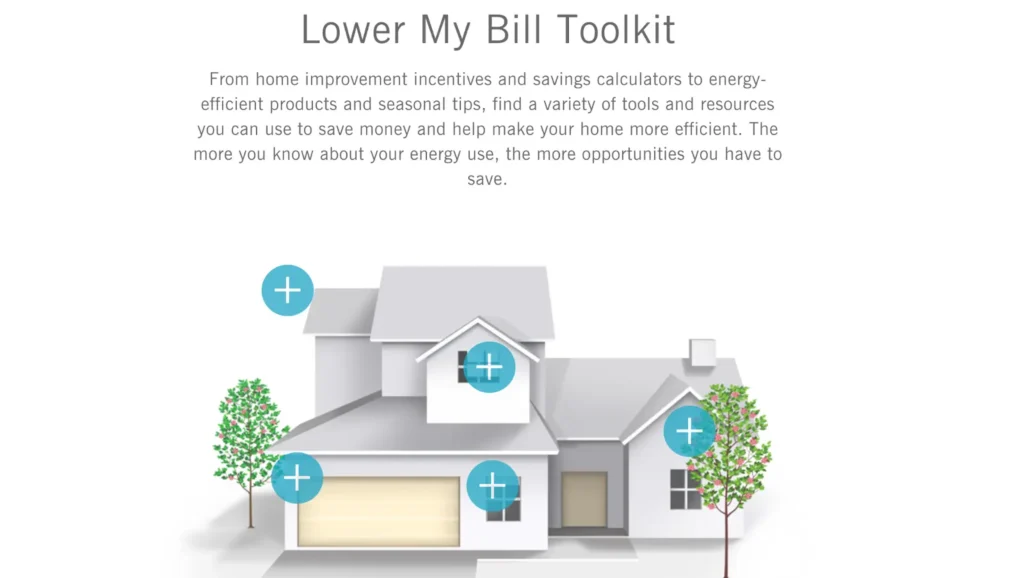
Image credit – Duke Energy’s “Find More Ways To Save” webpage
1. Create a blog and website
Yes, this is an obvious recommendation, but having a fast and accessible blog and website is fundamental. These platforms serve as the central hub for your brand, allowing you to showcase services, share success stories, and impart knowledge about energy efficiency.
As an example, ComEd’s blog is an effective, simply-structured and engaging website customers can use to learn more about their energy provider.
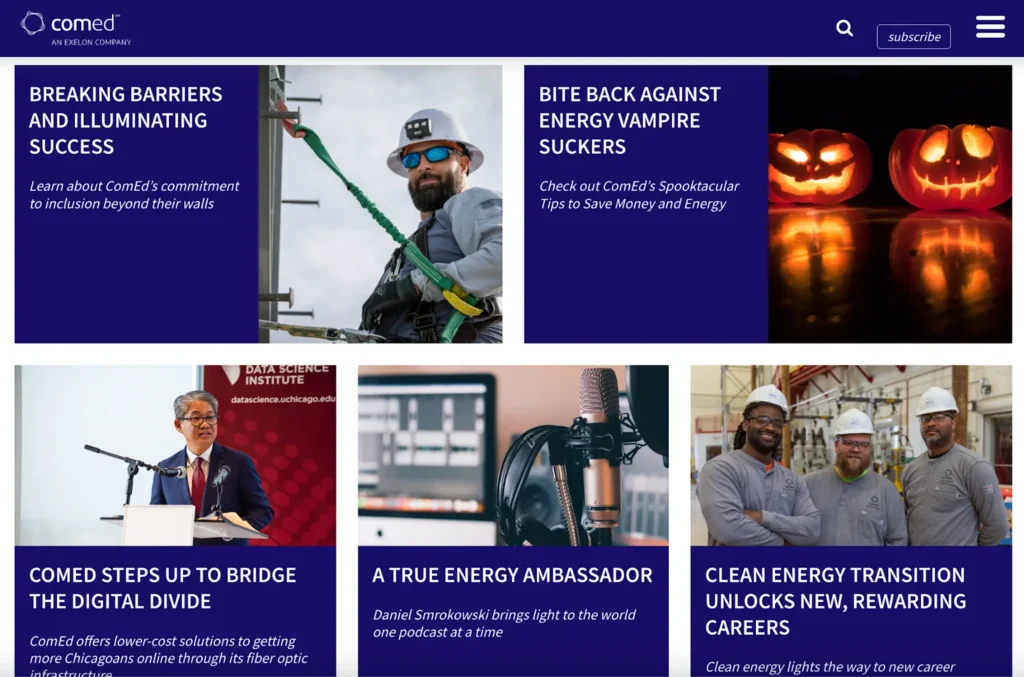
A well-structured website reinforces credibility, while a regularly updated blog positions your company as a trusted advisor to your customers.
2. Search Engine Optimization (SEO)
SEO is more than just a buzzword; it’s a strategic approach to ensure your content, advice and program pages surface when customers search online. By optimizing your website with relevant keywords, meta descriptions, and high-quality backlinks, you increase the likelihood of ranking higher on search engines like Google and Bing.
Con Edison in New York does a great job with SEO, with relevant results for customers searching for ‘efficiency rebates’. They have two very prominent results in position ‘Zero’ and position 1 in the results list.
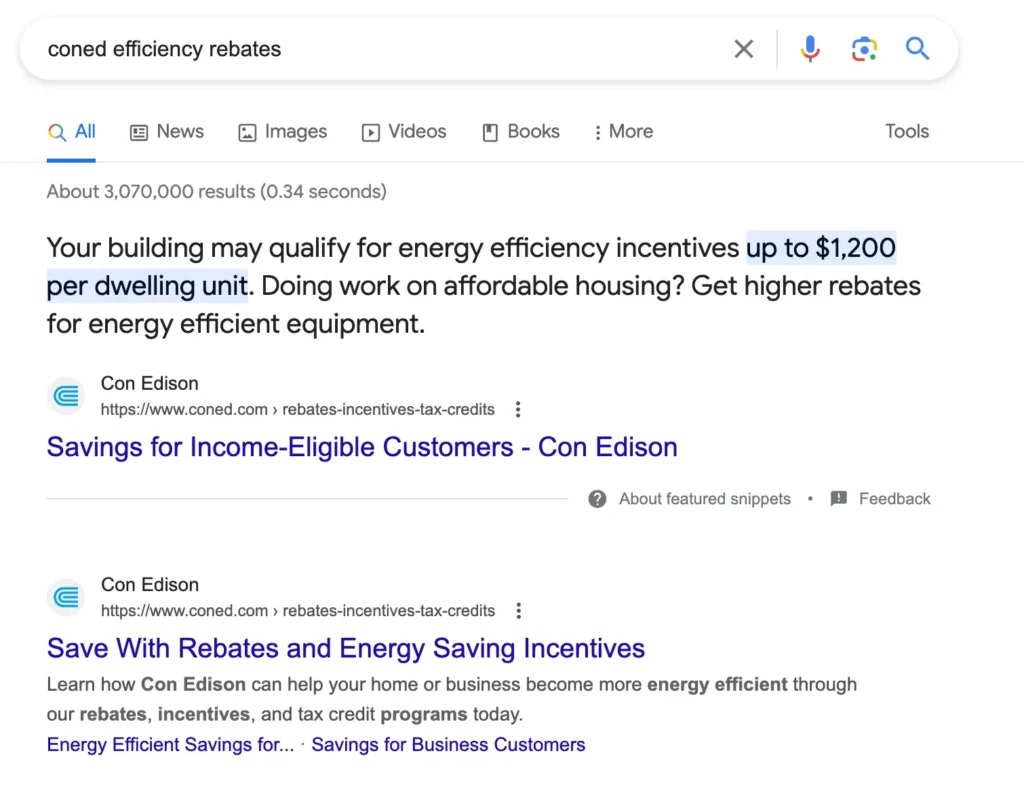
This organic visibility can significantly boost web traffic and, consequently, customer engagement and awareness around relevant energy efficiency programs or incentives.
3. Build a social media presence
Social media platforms like LinkedIn, TikTok, Instagram, X (formerly Twitter), Threads and Facebook are invaluable tools for utility companies and cities. They offer a space to share updates, engage with their communities, and highlight success stories. Regular posts, interactive content, and prompt response to queries can foster trust and amplify your brand’s reach.
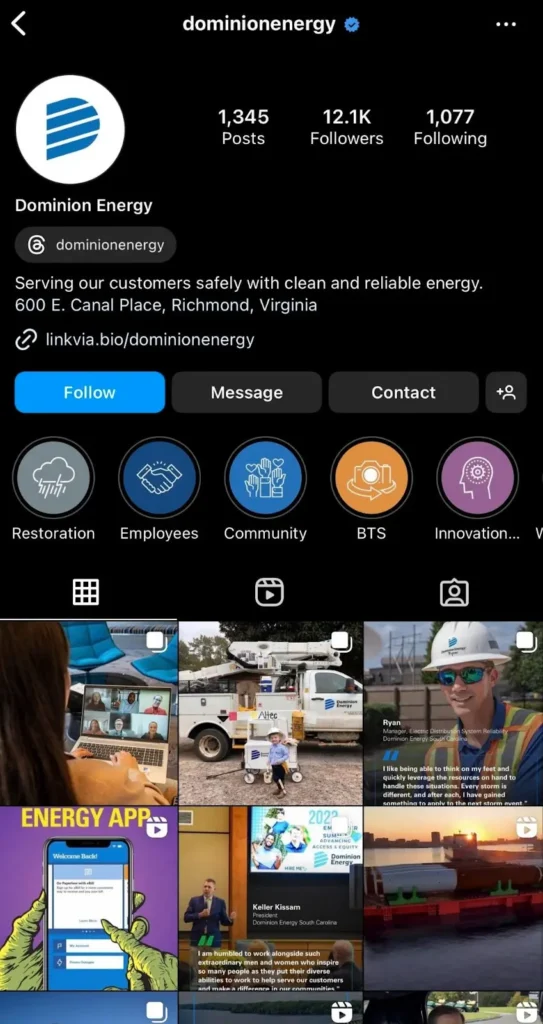
4. Advertise on social media and search engines
While organic (non-paid) reach is crucial, paid advertising can offer a targeted approach to reach potential clients. Platforms like Google Ads and Facebook Ads allow for precise audience targeting based on demographics, interests, and browsing behaviour. You can even target your customers on Google and Facebook ad platforms using the email lists you already have. With the right strategy, you can ensure your message resonates with those most likely to benefit from your services.
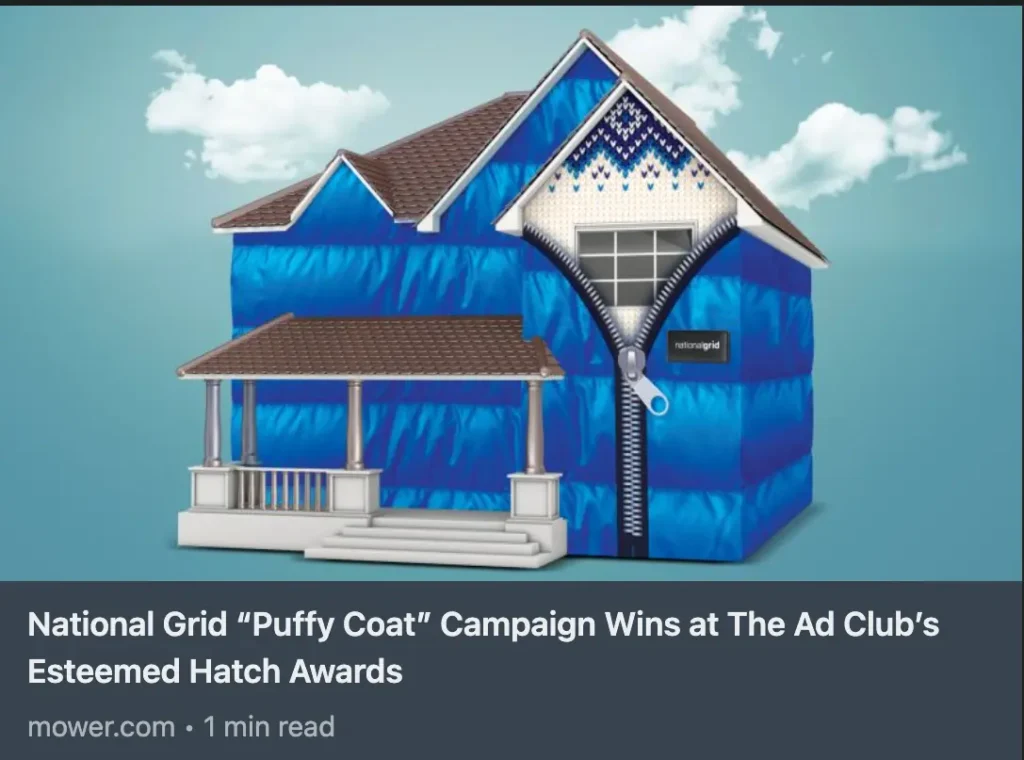
5. Attend and set up booths at conferences and markets
Conferences, industry events, and even local markets provide a unique opportunity to connect face-to-face with peers, customers, and industry experts. Setting up booths allows for direct engagement, product demonstrations, and real-time feedback. It’s an invaluable platform for networking and establishing collaborations.
PSEG in New Jersey regularly attend local events, in this case to promote energy efficiency in schools:
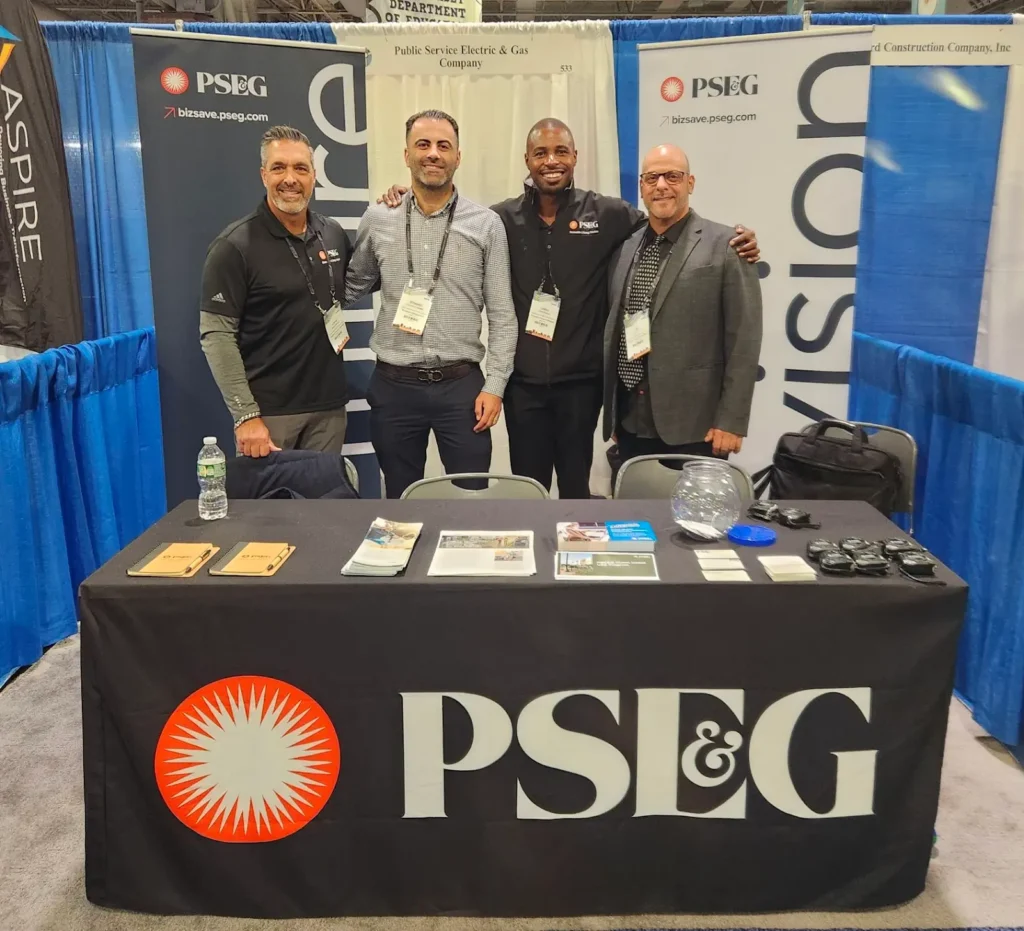
Photo credit – Steve Barba via LinkedIn
6. Get reviews from customers
Positive reviews act as testimonials, offering social proof of your services’ efficacy. Encourage satisfied customers to share their experiences on platforms like Google Reviews, Yelp, or directly on your website. These endorsements can significantly influence customers’ perceptions and decision-making.
7. Work with influencers and micro-influencers
Influencers, particularly those specializing in the energy sector or sustainability, can help extend your reach to a broader, yet targeted audience. Collaborating on content, hosting joint webinars, or having them review your services can bring authenticity and added visibility to your brand.
8. Build a mailing list
Email remains one of the most effective marketing channels. By building a mailing list, you have a direct line to your audience. Regular newsletters, updates, and exclusive offers keep your audience engaged and informed, fostering loyalty and repeat engagements.
9. Create an affiliate or referral program
Word-of-mouth remains a powerful tool in the digital age. By setting up an affiliate or referral program, you incentivize satisfied customers to spread the word. These programs can lead to increased program uptake, bolstered by the trust associated with personal recommendations.
10. Host webinars
Webinars are an excellent platform for in-depth exploration of topics, showcasing products, and facilitating real-time discussions. For instance, at MyHEAT, we collaborated with Saint John Energy and Efficiency Canada to present a webinar on how to promote heat pump rentals. Such events not only impart valuable insights but also establish your company as a thought leader in energy efficiency marketing.
15 Effective ideas for energy efficiency marketing
Now that you understand the best ways to promote energy efficiency services, how do you elevate those methods with unique, attention-grabbing tactics? Here are 15 effective ideas that will add that extra spark to your energy efficiency marketing campaign.
1. Promote homeowner property value
Energy efficiency is not just about monthly savings on utility bills; it’s an investment in the home’s future. Implementing energy-efficient solutions can significantly enhance a property’s market value. By reducing long-term costs and updating with modern, efficient systems, homeowners stand to gain a competitive edge in the real estate market.
2. Energy efficiency partnership opportunities
The energy market is vast, with numerous players all aiming for a sustainable future. Partnering with specialized climate tech firms can amplify the reach and impact of energy and utility companies. MyHEAT’s aerial mapping technology, for instance, offers a unique value proposition that can elevate energy efficiency campaigns. By identifying strategic alliances, businesses can leverage complementary strengths, expand their audience, and drive mutual growth.
3. Use energy efficiency case studies
Abstract numbers and promises often fall flat. But showcasing tangible results, complete with challenges faced and solutions implemented, speaks volumes. Detailed energy efficiency case studies underscore the real-world impact of energy efficiency, offering a transparent look into the journey and the results achieved.
4. Highlight customer testimonials
Imagine a homeowner sharing their positive experience after using a new energy-efficient appliance, stating how their energy bills significantly decreased or how the comfort level in their home improved. Such firsthand accounts, when showcased on your website or social media, resonate deeply with potential customers. By highlighting these real-world testimonials, energy efficiency companies can build trust and demonstrate the tangible benefits of their solutions, compelling others to take action.
5. Narrate energy efficiency success stories
Stories resonate. Sharing tales of clients who’ve transformed their energy consumption patterns, or cities that have revamped their energy grids, can captivate and inspire audiences. Take for example this story told by Laura, a homeowner in Canada, who used MyHEAT’s Heat Loss Maps to identify problem areas in her home. These narratives put a human face on energy efficiency, making the topic relatable and engaging.
6. Share energy efficiency facts
With misinformation rampant, it’s crucial to provide clear, factual information. Sharing compelling statistics, well-researched figures and tangible benefits of energy efficiency educates the audience, positioning your company as a trusted knowledge source.
7. Social media commitment
It’s not enough to have a passive presence on social media platforms like Facebook and LinkedIn. Active engagement, regular updates on energy efficiency programs, and prompt responses showcase a company’s dedication to energy efficiency and its audience.
8. Collaborate with sustainability influencers
Influencers in the sustainability niche command dedicated audiences interested in eco-friendly initiatives. Partnering with them provides businesses a platform to tap into an already engaged community, amplifying reach and gaining credibility.
9. Engage on video platforms
Visual content, especially video, has unparalleled engagement rates. Sharing insightful content on platforms like YouTube, Instagram Reels, and TikTok offers an interactive way to share tips, showcase products, and engage with a younger, tech-savvy audience.
10. Feature home energy assessments
By highlighting tools like MyHEAT’s heat loss mapping and showcasing other non-competitive assessment tools, companies can underline the importance and ease of home energy audits. These tools empower homeowners with knowledge, helping them make informed decisions.
11. Empower consumers
In today’s information age, consumers crave knowledge. For example, our solar potential calculator is a prime example of how businesses can provide valuable tools, enabling homeowners to gauge their property’s solar potential. By offering interactive tools and calculators, insights, and actionable advice, businesses can empower consumers to take proactive steps, fostering a sense of ownership and commitment to energy efficiency.
12. Rebate programs
Financial incentives are powerful motivators. By offering compelling rebate programs for energy-efficient products or solutions, utility companies can drive program adoption. For instance, consider the wide variety of New York State’s energy rebates. These incentives make the transition to energy-efficient solutions more appealing to potential clients, showcasing how state-led initiatives can bolster company offerings.
13. Sponsor sustainability events
Visibility at prominent eco-friendly events positions a brand as a leader in the sustainability movement. Sponsoring events or even hosting workshops and sessions can establish authority, engage with a like-minded audience, and foster collaborations.
14. Personalized experiences
Every client’s energy needs and consumption patterns are unique. By offering personalized insights, based on individual data and patterns, businesses can provide tailored solutions, enhancing customer satisfaction and efficacy. Learn more about how to use personalization to engage utility customers.
15. Promote energy literacy
Understanding energy consumption and its impact is the first step towards change. Through detailed guides, eBooks, and tools, like our guide on understanding energy loss, businesses can promote energy literacy, fostering a well-informed community ready to make energy-efficient choices.
3 Successful examples of energy efficiency marketing campaigns
Through MyHEAT’s innovative solutions, several of our energy efficiency campaigns with our partners have achieved significant impact, showcasing how technology and strategic outreach can drive tangible results. Let’s explore three standout initiatives from Union Gas, Medicine Hat, and Saint John Energy that leveraged MyHEAT’s platform.
1. How Union Gas boosted energy efficiency programs
In a groundbreaking campaign, Ontario-based Union Gas (now a part of Enbridge Gas) harnessed the power of visual heat loss data to bolster customer interest in their energy efficiency programs. By partnering with MyHEAT, they captured thermal data for thousands of homes, translating it into visual Heat Loss Maps. The result? A remarkable response rate through their direct mail and social media channels. Homeowners, equipped with personalized heat loss insights, were not only more engaged but were also directed towards Union Gas’s energy efficiency incentives. The campaign achieved response rates that significantly outstripped industry averages, emphasizing the efficacy of visual-driven marketing in the realm of energy efficiency. Check out the full Union Gas case study for an in-depth look.
2. How Medicine Hat motivated energy-saving action
In a collaboration with MyHEAT, the City of Medicine Hat, known as ‘The Gas City’, embarked on a mission to motivate homeowners towards energy-saving actions. Through a randomized controlled trial, the campaign utilized visual heat loss imagery to drive behavioural change. With a 240% decrease in energy consumption in the Heat Loss group and a significant 28% uptick in applications for weatherization, the campaign showcased the power of visual nudges in energy efficiency marketing. Read our full case study on the city of Medicine Hat.
3. How Saint John Energy increased heat pump rentals and online accounts
Addressing the challenge of heritage homes leading to higher heating costs, Saint John Energy collaborated with MyHEAT, introducing the “Home Heat Saver” program. This initiative led to a 90% boost in online accounts and a 28% rise in traffic to their heat pump rental page, affirming the success of their energy efficiency marketing. Dive deeper into the Saint John Energy heat pump rental campaign in our detailed case study.
How MyHEAT elevates your energy efficiency goals
At MyHEAT, our mission aligns with the essence of effective energy efficiency marketing. We provide educational tools and services, collaborate with cities, and work alongside energy and utility companies. With our aerial visualization tools, we make it easy for consumers to understand their home’s heat loss and solar potential.
Work with MyHEAT – Together, we can engage your customers, reduce energy consumption, and make strides towards a sustainable future. Discover how our HEAT Maps can revolutionize energy efficiency for your customers.


